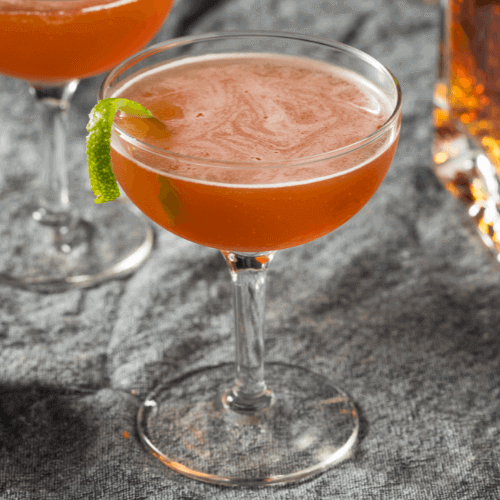Table of Contents Cocktail culture is a dynamic world where tradition and innovation intersect to create new flavor experiences. The...

The Japanese cocktail is a drink that stands out for its elegant simplicity and the intriguing blend of flavors it offers. This cocktail features a base of Cognac, which is combined with orgeat syrup and aromatic bitters, usually Angostura or Peychaud’s. The result is a balanced drink that is both refreshing and complex. This cocktail, despite its name, has no direct historical connection to Japan. Its moniker likely derives from the use of ingredients like orgeat syrup, which has a sweet almond flavor reminiscent of Japanese marzipan treats.
Cognac: The use of Cognac as the base spirit imparts a rich and mellow character to this cocktail. Cognac, a type of brandy, is known for its complex flavors, often featuring notes of dried fruits, oak, and vanilla. It is the backbone of this cocktail and provides a solid foundation for the other ingredients.
Orgeat Syrup: Orgeat syrup is a sweet syrup made from almonds, sugar, and orange flower water. It adds a delightful nutty sweetness to the cocktail, balancing the boldness of the Cognac. The hint of orange flower water also contributes a subtle floral aroma that complements the other components.
Aromatic Bitters: A few dashes of aromatic bitters, such as Angostura or Peychaud’s, are used to provide depth and complexity to the Japanese Cocktail. These bitters add layers of flavor, with hints of spices, herbs, and citrus, enhancing the overall taste profile.
The Japanese Cocktail, like many classic cocktails, owes its existence to the pioneering work of Jerry Thomas, a legendary bartender who made significant contributions to the world of mixology in the mid-19th century. Jerry Thomas is often regarded as the “father of American mixology” and his fame reached new heights when he appeared in the 1862 edition of “How to Mix Drinks or The Bon Vivant’s Companion”
In this iconic cocktail manual, Jerry Thomas introduced a wealth of innovative recipes and techniques that laid the foundation for modern bartending. His meticulous attention to detail and showmanship behind the bar made him a beloved figure in the world of cocktails. The Japanese Cocktail was one of his notable creations, showcasing his talent for balancing flavors and creating memorable drinks.
His book “How to Mix Drinks” in 1862 marked a pivotal moment in the history of mixology, setting a standard for the craft that endures to this day.
Jerry Thomas’s legacy as a bartender and his contributions to the world of cocktails continue to influence bartenders and mixologists worldwide. The Japanese Cocktail, among his many creations, serves as a reminder of his enduring impact on the world of beverages, inspiring bartenders and cocktail enthusiasts alike to explore the art of mixing drinks and savoring the timeless creations of the past.
60 ml Cognac
15 ml orgeat syrup
2 dashes of Angostura bitters
Ice
Garnish: lemon twist

Add the Cognac, orgeat syrup, and Angostura bitters into a cocktail shaker.
Add ice and shake for 10-12 seconds, until chilled.
Strain into a cocktail glass.
Garnish with a lemon twist.
“How to Mix Drinks, or the Bon Vivant’s Companion” is a timeless classic in the world of cocktail culture. First published in 1862 by Jerry Thomas, this book serves as a foundational text for bartenders and cocktail enthusiasts alike. Thomas, a renowned mixologist of his time, laid the groundwork for modern mixology with this comprehensive guide.
The book is not merely a collection of recipes, it is a historical artifact that offers insights into the drinking culture of the 19th century. It covers a wide array of cocktails, from the iconic Martini and Manhattan to lesser-known cocktails. Each recipe is accompanied by detailed instructions and anecdotes, showcasing Thomas’s passion for his craft.
Beyond its practicality, “How to Mix Drinks” captures the essence of conviviality and the art of hospitality. It emphasizes the importance of quality ingredients, proper techniques, and presentation. The book’s enduring appeal lies in its ability to transport readers back to a bygone era while providing a wealth of knowledge for contemporary mixologists. In essence, it is a delightful journey through time and taste, making it an indispensable reference for anyone interested in the art of mixing drinks.
Table of Contents Cocktail culture is a dynamic world where tradition and innovation intersect to create new flavor experiences. The...
Facebook Print Email WhatsApp Table of Contents Among the vast array of cocktails, the Cucumber Southside stands out as a...
Facebook Print Email WhatsApp Table of Contents The Kir Breton is a delightful French cocktail, that brings the rich heritage...
Facebook Print Email WhatsApp Table of Contents The White Christmas Margarita is a delightful and festive cocktail that captures the...
MixDrinkiPedia.com is a participant in the Amazon.com Services LLC Associates Program. As an Amazon Associate we earn from qualifying purchases. Amazon and the Amazon logo are trademarks of Amazon.com, Inc. or its affiliates.